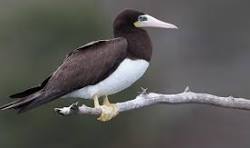Brown Booby: A Seabird’s Grace and Survival in the US Virgin Islands’ Coastal Ecosystems
Introduction to the Brown Booby in the US Virgin Islands
The US Virgin Islands, renowned for their stunning beaches and rich biodiversity, are also home to a variety of seabirds, including the Brown Booby. This avian species, scientifically known as Sula leucogaster, is a captivating sight along the coasts, with its striking appearance and unique ecological adaptations.
Physical Characteristics
The Brown Booby is a medium-sized seabird, characterized by its robust build and long, pointed wings. Adults typically measure between 71 to 81 cm (28 to 32 inches) in length, with a wingspan ranging from 137 to 150 cm (54 to 59 inches). They exhibit sexual dimorphism, where males and females differ slightly in size, with males being slightly larger on average.
One of the most distinctive features of the Brown Booby is its plumage. Adults typically have a uniform brown body, which varies from dark chocolate brown to almost black on the upperparts and wings. The underparts are usually white, extending up to the face and neck, giving the bird a contrasting appearance. Juveniles, however, display a more mottled brown and white plumage, which gradually changes as they mature.

The Brown Booby bird in flight
Habitat and Distribution
Brown Boobies are widely distributed across tropical and subtropical regions worldwide. In the US Virgin Islands, they are primarily found nesting on remote offshore islands and cliffs. These locations provide them with the necessary isolation and protection needed for breeding and raising their young.
Their habitat preference includes rocky cliffs, coastal islands, and sometimes mangrove forests near shallow waters. They are known for their excellent diving capabilities, plunging from heights to catch fish and squid, which are their primary diet.
Behavior and Reproduction
The Brown Booby is a proficient fish hunter, employing a distinctive hunting technique called plunge diving. This involves soaring to considerable heights before folding their wings and diving steeply into the water to catch prey. This behavior not only aids in efficient feeding but also helps them survive in their marine environment.
During the breeding season, which varies depending on the region, Brown Boobies form monogamous pairs and build their nests on the ground or in low trees and shrubs. In the US Virgin Islands, nesting sites are carefully chosen to avoid predators and disturbances. Both parents take turns incubating the eggs and feeding the chicks after they hatch.
Conservation Status and Threats
While the Brown Booby is not currently considered globally threatened, certain local populations face threats from habitat loss, human disturbance, and pollution. Conservation efforts in the US Virgin Islands focus on protecting nesting sites and raising awareness about the importance of preserving these seabird populations.
Interaction with Humans
In the US Virgin Islands, Brown Boobies are often admired by tourists and locals alike for their graceful flight and striking appearance. However, human activities such as coastal development, tourism, and recreational boating can inadvertently disturb nesting colonies and disrupt their natural behavior. Conservation efforts emphasize responsible tourism practices and minimizing human impact on their habitats.

Brown Booby bird
The Brown Booby is a remarkable seabird that contributes to the ecological diversity of the US Virgin Islands. With its distinctive plumage, adept diving skills, and important role in marine ecosystems, it serves as a symbol of the region’s natural heritage. Conservation efforts play a crucial role in ensuring the continued survival of this species, balancing human activities with the need to protect their nesting sites and habitats.
In summary, the Brown Booby’s presence in the US Virgin Islands highlights the interconnectedness between wildlife conservation and sustainable tourism, offering a glimpse into the delicate balance required to preserve these majestic seabirds for future generations to appreciate and study.
